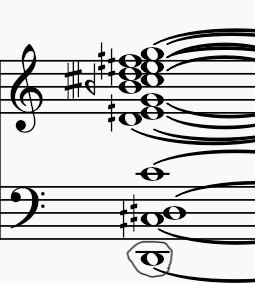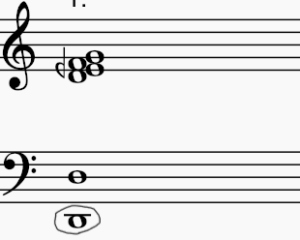In the final work, I felt there were aspects that came across very strongly, whilst other points could have done with more refinement and improvement. One of the main points that I felt worked well was, in spite of the very clear distinctions between the sections, there was still continuity within the whole sound world. This is something that was designed into my sounds, with all of the chords being rooted with the note D. Even the improvisation was extremely rooted within the note D. This ‘implied drone’ throughout meant that even when there was a dramatic shift in sound, there was still some kind of ‘rooting’ to the sound world.



Figure 1: highlighting the rooting of D.
This focus on a single fundamental note across a long time is heavily influenced by the French composer Gérard Griseys 90 minute cycle les espaces acoustiques, which is entirely based on the same low E (Féron, 2011).
However, even if there was strong musical connections, there were some issues with panning between the sections, which lent to the changes being less smooth than planned. Although a lot of this was down to issues within MaxMSP, which wasn’t my part of the project, the individual sounds I created could have been faded in/out in a smoother manner, to make this process easier.
Another strength of the project was the sensors being used, which worked really well, and centered interaction in the instillation. It was commented on that the sensors, which controlled the visuals and the sounds, functioned like a musical instrument. This was an interesting observation, and curiously recontextualized my own perception of the sensors interaction. Instead of being seen as a series of sensors, it felt more like an experimental, electronic, sound and visual autoharp, an instrument which produces chords by suppressing keys (Kennedy et al, 2013, p. 28). The autoharp is purely harmonic, with limited control of what is possible. Similarly, the sensors allow for a degree of control, however, it is limited to the set of sounds we created for it, many of which are chords, though distinctly non-triadic and non-tertian, the typical chords used in functional tonal harmonic practice (Persichetti, 1961, p. 66). The one small issue with the sensors, was with the light sensor. The sensor itself worked very well, and was sensitive to changes in light. However, because of the darkness of the room, it would only respond strongly to torchlight, typically that of a phone torch. Although this work effectively, it did feel slightly awkward to work the other sensors with the phone in hand. Likewise, this made the instillation inaccessible to those who don’t own a smartphone, or a phone with a torch in general. In hindsight, I should have planned to source a light that would mean the light sensors didn’t require the use of a phone torch, whilst also not messing with the rest of the instillation.
I felt the sea-creature layer and the chaos layer worked very well and was happy with how the sound turned out. The sounds/chords created fit very well within the sound world, as they had strong thematic ties to their respective concepts. However, I wasn’t as certain about the harmonic structure in the unknown layer. This was the most difficult to represent from my perspective as a composer; how does one represent the unknown through sound? One of the ideas as to use the harmonic series, a series of ascending pitches from a fundamental which regularly occur in most acoustic sounds (Kennedy et al, 2013, p. 207), as the basis of the harmonic language. This would have been justified as ‘bringing out the unknown sounds around us’, but the aesthetic quality of this kind of harmony didn’t evoke fear in my mind. The denser, microtonal harmonies I felt got closer to this idea, exploring sounds unknown to the 12 tone system used predominantly in western music (Wood, 1986). However, some of the chords felt more curious, and peculiar, rather than evoking fear. In hindsight, I should have spent more time focusing on the harmonic structure of this section, as I was more comfortable with the rest of the material.
Another part I felt need further improvement and additions was in the calmness/peaceful layer. Although I was happy with my chords and harmonic structure in this section broadly, I felt more could have been added in terms of sound material. Most of the sound design at that point was stripped down as a deliberate creative choice, which did make sense as a representation of the calm. I should have responded more so on my end with more additions of ‘musical’ sounds to fill in, as everything dropped away, and felt slightly too sparse. Here are some of the sounds that could have been used in hindsight, using different timbres of the note D on the piano.
Lastly, a final critique mentioned was the lack of high fidelity sounds. All sound was heavily weighted towards the lower and middle frequencies, and therefore, didn’t fill out the whole frequency spectra. In our defense however, it is arguably thematically appropriate to focus more on lower frequencies, as there is more of a sense of being ‘under the water’. Likewise, the spectral analysis that was done to the sea creature sounds and the whalesong showed more prominent partials in the lower and mid frequencies.

Figure 2, spectral analysis of one of the sea creature sound effects in layer 1 (spectral analysis done using the program SPEAR).
That being said, this lack of high fidelity sound does create a less ‘full’ sound quality , and overall feels slightly less immersive than desired. If this instillation was to be done in the future, I would likely add only one other track; a droning improvisation using the high D notes on the piano. There was a last minute idea to add this on during the work live as there was a piano in the room. However, this might have meant the instillation would be perceived as a live performance. For context, this is a rough mock up of what the track could potentially be.
I would have this track play cyclically throughout the work, which would possibly have the second benefit of smoothing the transitions between the sections.
In conclusion, there was a lot of space for improvement and refinement to my sounds, both how some of them where formed, and with more additions to create a fuller experience. Even in terms of the broader ideas of the instillation there was space to improve, for example, clarity of the theme of thalassophobia could have been improved when presenting the instillation. However, the instillation felt strong, and received mostly positive feedback. In spite of the places to improve on for future practice, the project was overall effective, and I believe showcased each of our individual strengths of multimedia programming, sound design, and composition, contributing to a single, consistent, well formed multimedia instillation.
Reference list.
Féron, F.-X. (2011) The Emergence of Spectra in Gérard Grisey’s Compositional Process: From Dérives (1973-74) to Les espaces acoustiques (1974-85). Contemporary music review. 30 (5), pp. 343–375.
Kennedy, K. Kennedy, M. and Rutherford-Johnson, T. (2013). The Oxford dictionary of music. 6th Ed. Oxford: Oxford University Press.
Persichetti, V. (1961). Twentieth Century Harmony: Creative aspects and practice. New York: W.W Norton.
Wood, J. (1986). Microtonality: Aesthetics and Practicality. The Musical Times, 127 (1719), pp. 328–330.

